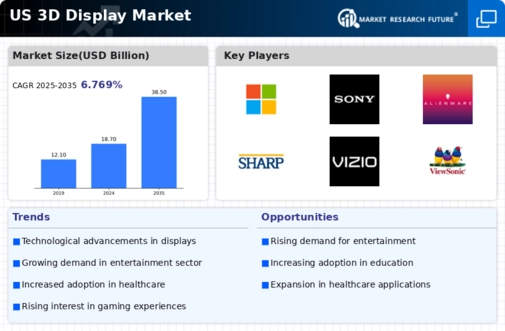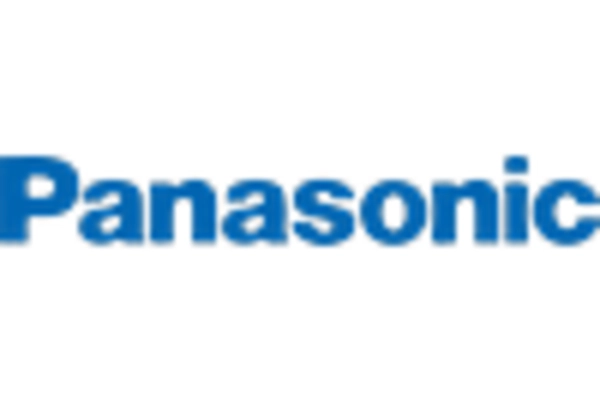Expansion in Retail and Advertising
The 3 d-display market is witnessing a transformative shift in retail and advertising sectors, where businesses are increasingly adopting 3 d displays to enhance customer engagement. Retailers are utilizing these displays to create eye-catching product presentations that attract consumers' attention. Data indicates that retailers using 3 d displays can experience up to a 30% increase in customer interaction compared to traditional displays. This trend is particularly relevant in high-traffic areas, where visually striking displays can significantly influence purchasing decisions. Furthermore, advertising agencies are leveraging 3 d displays to create memorable campaigns that resonate with audiences. The ability to present products in a more dynamic and interactive manner is becoming a key differentiator in a competitive market. As a result, the 3 d-display market is likely to see continued growth as businesses recognize the value of innovative display solutions in driving sales and enhancing brand visibility.
Integration of 3D Displays in Education
The The 3D display market is increasingly finding applications in the education sector., where institutions are adopting 3 d displays to enhance learning experiences. These displays facilitate interactive and engaging educational content, allowing students to visualize complex concepts in a more tangible manner. Research indicates that educational institutions utilizing 3 d displays can improve student engagement and retention rates by up to 40%. This trend is particularly relevant in fields such as science, engineering, and medicine, where 3 d visualizations can significantly aid comprehension. As educational technology continues to evolve, the demand for innovative teaching tools is likely to rise, driving growth in the 3 d-display market. Furthermore, the integration of 3 d displays into virtual classrooms and remote learning environments is expected to expand, providing students with immersive learning experiences regardless of their location.
Rising Demand for Immersive Experiences
The 3 d-display market is experiencing a notable surge in demand for immersive experiences across various sectors. This trend is particularly evident in the entertainment industry, where consumers increasingly seek engaging content that enhances their viewing experience. According to recent data, the market for immersive technologies is projected to grow at a CAGR of approximately 25% over the next five years. This growth is driven by advancements in display technology, which allow for more realistic and captivating visuals. As a result, companies are investing heavily in 3 d-display solutions to meet consumer expectations. The increasing popularity of virtual reality (VR) and augmented reality (AR) applications further fuels this demand, as these technologies rely heavily on high-quality 3 d displays to create lifelike environments. Consequently, the 3 d-display market is poised for significant expansion as it caters to the evolving preferences of consumers seeking immersive experiences.
Technological Advancements in 3D Imaging
The 3 d-display market is significantly influenced by ongoing technological advancements in 3D imaging techniques. Innovations such as holography and light field technology are enhancing the quality and realism of 3 d displays, making them more appealing to consumers and businesses alike. These advancements enable the creation of displays that do not require special glasses, thereby improving user experience and accessibility. The market for 3D imaging technology is expected to grow substantially, with estimates suggesting a CAGR of around 20% over the next few years. This growth is driven by the increasing demand for high-quality visual content in various applications, including gaming, education, and training. As these technologies continue to evolve, the 3 d-display market is likely to benefit from enhanced product offerings that cater to diverse consumer needs, further solidifying its position in the technology landscape.
Increased Investment in Gaming Technologies
The The 3D display market is benefiting from increased investment in gaming technologies., as developers seek to create more immersive gaming experiences. The gaming industry is one of the primary drivers of demand for high-quality 3 d displays, with consumers increasingly expecting realistic graphics and engaging gameplay. Recent estimates suggest that the gaming market is projected to reach $200 billion by 2026, with a significant portion of this growth attributed to advancements in display technologies. As gaming consoles and PCs become more powerful, the need for superior display solutions becomes paramount. This trend is likely to encourage manufacturers to innovate and enhance their 3 d display offerings, catering to the evolving preferences of gamers. Consequently, the 3 d-display market is poised for growth as it aligns with the expanding gaming sector and the demand for cutting-edge visual experiences.
















Leave a Comment